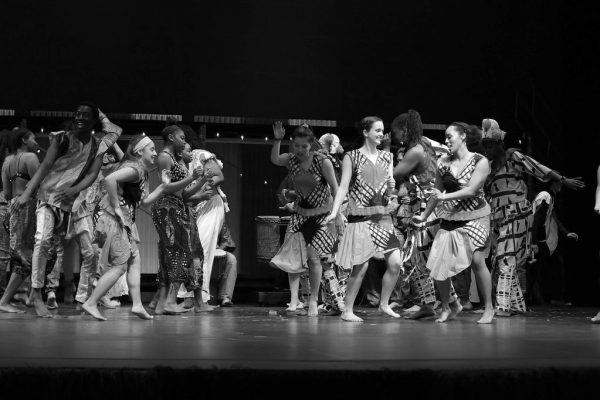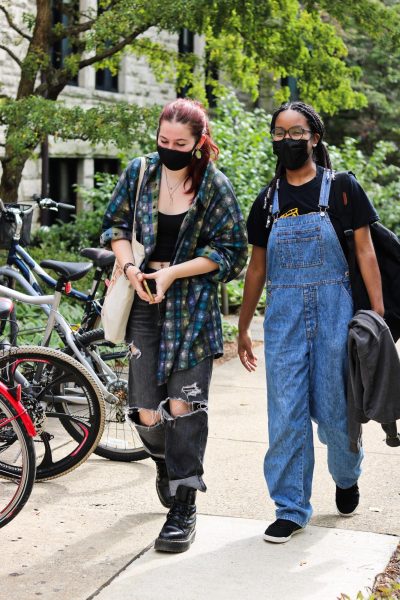Campus Cornerstones: The History Buried in Our Walls
Editor’s note: This column is part of a series that will focus on Oberlin’s history as a town and an institution. The series will be published regularly throughout the fall semester.
In January 1886, just over two decades after it was built, Oberlin’s second Ladies’ Hall burned down. After the smoke of Oberlin’s first major fire cleared, the building’s cornerstone was opened, revealing a collection of documents placed inside when it was originally laid in 1861. It was common practice in early Oberlin to fill cornerstones with mementos of the time, not to be viewed again until the building they supported came down.
Among the second Ladies’ Hall collection was the town’s charter; Oberlin College 1861 rules and regulations, including specific guidelines for the Ladies’ Department; informational documents submitted by local churches, including the still-standing First Church in Oberlin; and copies of various newspapers, including The Students’ Monthly (the Review did not begin publishing until 1874).
All told, the documents revealed a lot about the character of Oberlin in 1861 — a town firmly invested in the abolitionist cause, that watched the events of the recently-begun Civil War with great interest and anxiety. It was the first cornerstone laid in Oberlin with a time capsule concealed inside, and thus its contents held great interest for the community at large — many of whom were alive when the Ladies’ Hall was built.
“These unburied documents bring back a vivid picture of the troublous times when those foundations were laid,” Professor of Philosophy J.M. Ellis said to an assembled crowd, according to the Oct. 29, 1886 issue of the Oberlin Weekly News.
The event at which Ellis discussed the contents of the cornerstone not only commemorated the Ladies’ Hall — it also celebrated a new cornerstone being laid for the building’s replacement.
The new dorm was Talcott Hall. Built of stone instead of brick at the request of its largest benefactor, a New York businessman named James Talcott, the new dorm represented Oberlin’s progress in many ways. The original Obies — who faced the near failure of their community and utopian vision due to financial woes — could not have imagined the construction of such a sturdy building, a testament to the stability and permanence Oberlin intended to project into the approaching 20th century and beyond.
“When will [the stone] be opened and read? Let us hope not till we all and our children and our children’s children for many generations have passed away,” Ellis said at the same ceremony, speaking to the hope and optimism built into Talcott’s foundations.
Ellis and other College administrators and leaders, as well as the gathered students and community members, must have also wondered how they would be understood when the contents of Talcott’s cornerstone are finally opened.
Indeed, according to press coverage at the time, the cornerstone contains a wealth of information about Oberlin in 1886. Even as Ellis envisioned a strong and stable Oberlin, this was, in retrospect, a community struggling to find its identity in a post-Civil War world, when so much of its early energy had been focused on the since-resolved question of abolition.
To the best of my knowledge, Talcott’s front porch still contains all of these documents — which include lists of course offerings; copies of several newspapers, including the now-publishing Review; a photograph of Oberlin President James Fairchild; copies of addresses made at the celebratory events; and others — within the stone engraved “Laid October 21, 1886” (with the tasteful addition of “I got” scratched in above).
Whether or not these documents have survived the elements over the more than 130 years since they were sealed off is another question. Perhaps not even Ellis and others who hoped for the dorm’s longevity imagined that Talcott would still be standing, let alone a functional living space, in 2019.
If the documents remain intact, Talcott’s cornerstone probably has quite a bit to say about the state of Oberlin and the broader United States in 1886, just as the second Ladies’ Hall’s cornerstone revealed much about the spirit of a community and nation in the early days of a vicious and bloody civil war.
It would likely also reveal small, otherwise-forgotten details about individual lives and places — many of which likely felt urgent in the moment, but have faded over time and space. Perhaps these details didn’t shape the direction of a community, an institution, or a country — but the fact that some people, at some point, cared about them matters to our collective history.
There’s a lot to be gained from focusing on major historical events and identifying turning points and significant trends. However, I think there’s also great value in pausing to look at individual moments, however mundane they may seem, and listening to what people were saying about their daily lives.
What are the tidbits, the vignettes, the snapshots preserved in Talcott’s cornerstone? What is waiting to be revealed in Oberlin’s other cornerstones, laid to herald the construction of other campus buildings? What would we choose to store if we were to create another cornerstone today, not to be opened for another century?
The care taken in curating materials to store in Talcott’s cornerstone speaks through time in a profound way. Oberlin’s leaders in 1886 wanted to be known by people from the future — wanted their hopes, dreams, disappointments, and more mundane thoughts to be recorded, preserved, and ultimately read.
There’s vulnerability in such a commitment, but also deep care and accountability, as well as a sense that history will want to remember Oberlin. Presuming that someday in the future some people will open Talcott’s time capsule, and that those people from the future will understand the perspectives stored within, requires a great deal of faith.
Oberlin is again in a moment of fraught balance between campus optimism and pessimism caused by a challenging national climate. The world today is entirely different from when Talcott was built, but perhaps we could still learn from the vulnerability, accountability, and trust built into its walls.




